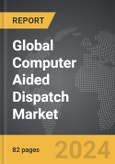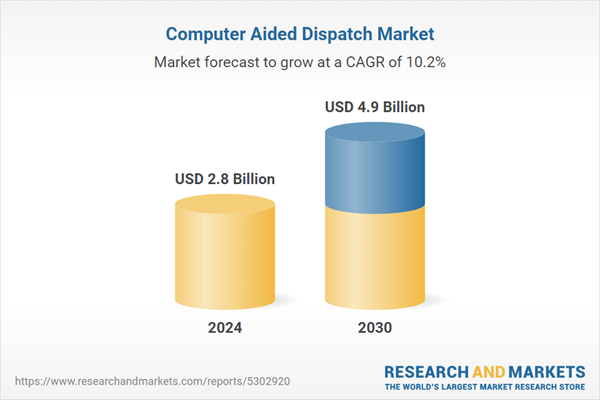Global Computer-Aided Dispatch (CAD) Market - Key Trends & Drivers Summarized
What Is Computer-Aided Dispatch (CAD), and Why Is It Vital for Emergency Response?
Computer-Aided Dispatch (CAD) systems are software platforms designed to manage and coordinate emergency response services, including law enforcement, fire departments, and emergency medical services (EMS). CAD systems enable dispatchers to efficiently allocate resources, track unit locations in real time, and manage incident data to ensure swift and organized responses. These systems integrate GIS mapping, automated alerts, and communication tools that help dispatchers make rapid, informed decisions. The data-driven approach of CAD improves situational awareness, allowing first responders to arrive at scenes faster, communicate seamlessly, and make better decisions under pressure. CAD systems have become indispensable in modern emergency response as they reduce response times and increase the effectiveness of emergency services. The importance of CAD lies in its ability to streamline emergency operations, from receiving a 911 call to coordinating the deployment of police, fire, or medical personnel. CAD systems manage a vast amount of real-time information, including caller details, incident history, and the location of available units, allowing dispatchers to prioritize resources and improve coordination. This efficiency is critical in life-threatening situations, where minutes can mean the difference between life and death. CAD systems not only enhance response time but also provide a central hub of information that supports the entire emergency response workflow, from dispatch to reporting. By improving resource management, CAD systems support safer, more organized, and more efficient emergency operations.How Are Technological Advancements Shaping the CAD Market?
Technological advancements are continuously improving CAD systems, enhancing their capabilities and broadening their applications. One significant innovation is the integration of Geographic Information System (GIS) mapping, which allows dispatchers and responders to access real-time, precise location data on incidents, units, and resources. This geographic data enhances situational awareness and helps dispatchers route units through the fastest or safest routes. Additionally, the incorporation of mobile data terminals (MDTs) in emergency vehicles allows responders to access CAD information directly, enabling better situational understanding, two-way communication, and access to incident details while en route. This connectivity reduces radio traffic and increases response accuracy. Cloud-based CAD solutions are another transformative trend, providing scalable, secure, and cost-effective options for agencies of all sizes. Cloud CAD systems allow for flexible access and simplify data sharing across agencies, facilitating faster multi-jurisdictional coordination in large-scale incidents. Advancements in artificial intelligence (AI) are also playing a role, with predictive analytics enabling CAD systems to forecast resource needs based on patterns, optimize deployment, and reduce unnecessary dispatches. Furthermore, the integration of video streaming from drones or body cams provides real-time visuals that enhance the dispatcher's ability to assess situations accurately. Together, these advancements make CAD systems more adaptable, accessible, and powerful, supporting faster and more efficient emergency response operations.What Are the Key Applications of CAD Systems Across Emergency Services?
CAD systems are critical across various emergency services, each benefiting from the efficiency and data management capabilities these systems provide. In law enforcement, CAD systems streamline dispatching by connecting officers with live incident data, providing access to past incident reports, and offering real-time updates on crime scenes. This helps officers arrive prepared and improves coordination between patrol units. Fire departments also rely on CAD systems to monitor active incidents, track equipment status, and prioritize resources based on the severity and type of fire. The ability to assess scene data in real time, coupled with mapping, enhances firefighter safety and operational efficiency.In EMS, CAD systems are vital for prioritizing emergency medical calls, dispatching the nearest ambulance, and providing real-time patient information. CAD can track available beds in nearby hospitals, routing patients to the most appropriate facility, which is essential in critical care situations. Additionally, CAD systems support multi-agency responses, enabling police, fire, and EMS to coordinate seamlessly during major incidents. Some systems are also used in non-emergency dispatch settings, such as transportation services, utilities, and municipal services, where dispatch efficiency is equally important. The versatility of CAD systems allows them to support diverse dispatch needs, improving response coordination and effectiveness across emergency and public service sectors.
What Factors Are Driving Growth in the CAD Market?
The growth in the CAD market is driven by several factors, including increasing demand for efficient emergency response systems, technological advancements, and regulatory support for modernized public safety infrastructure. As urban populations grow, the need for fast and organized emergency responses has intensified, prompting municipalities and agencies to adopt CAD systems that can handle high call volumes and complex logistics. Technological innovations, such as GIS mapping, mobile connectivity, and AI-driven analytics, have expanded the capabilities of CAD systems, making them more effective at optimizing resource allocation, tracking incidents, and predicting service demand. Furthermore, government initiatives and funding for public safety modernization have boosted CAD adoption in both urban and rural areas, especially as agencies seek to improve interoperability across jurisdictions. The rise of cloud-based CAD solutions, which offer cost savings and ease of scalability, has further accelerated market growth by making CAD systems accessible to smaller agencies with limited budgets. Additionally, the increasing integration of CAD systems with other public safety technologies, such as body cameras, drones, and IoT sensors, supports real-time data collection and situational awareness, making them a critical component of today's emergency response strategies. Together, these factors create a robust demand for CAD systems, with growth driven by the need for rapid, coordinated, and data-driven emergency response capabilities.Report Scope
The report analyzes the Computer Aided Dispatch market, presented in terms of market value (US$ Thousand). The analysis covers the key segments and geographic regions outlined below.- Segments: Component (Software, Services); Vertical (Public Safety, Transportation, Government & Defense, Healthcare, Power & Utilities, Other Verticals).
- Geographic Regions/Countries:World; United States; Canada; Japan; China; Europe (France; Germany; Italy; United Kingdom; Spain; Russia; and Rest of Europe); Asia-Pacific (Australia; India; South Korea; and Rest of Asia-Pacific); Latin America (Argentina; Brazil; Mexico; and Rest of Latin America); Middle East (Iran; Israel; Saudi Arabia; United Arab Emirates; and Rest of Middle East); and Africa.
Key Insights:
- Market Growth: Understand the significant growth trajectory of the Software Component segment, which is expected to reach US$3.1 Billion by 2030 with a CAGR of a 9.9%. The Services Component segment is also set to grow at 10.7% CAGR over the analysis period.
- Regional Analysis: Gain insights into the U.S. market, valued at $709.7 Million in 2024, and China, forecasted to grow at an impressive 13.5% CAGR to reach $1.1 Billion by 2030. Discover growth trends in other key regions, including Japan, Canada, Germany, and the Asia-Pacific.
Why You Should Buy This Report:
- Detailed Market Analysis: Access a thorough analysis of the Global Computer Aided Dispatch Market, covering all major geographic regions and market segments.
- Competitive Insights: Get an overview of the competitive landscape, including the market presence of major players across different geographies.
- Future Trends and Drivers: Understand the key trends and drivers shaping the future of the Global Computer Aided Dispatch Market.
- Actionable Insights: Benefit from actionable insights that can help you identify new revenue opportunities and make strategic business decisions.
Key Questions Answered:
- How is the Global Computer Aided Dispatch Market expected to evolve by 2030?
- What are the main drivers and restraints affecting the market?
- Which market segments will grow the most over the forecast period?
- How will market shares for different regions and segments change by 2030?
- Who are the leading players in the market, and what are their prospects?
Report Features:
- Comprehensive Market Data: Independent analysis of annual sales and market forecasts in US$ Million from 2024 to 2030.
- In-Depth Regional Analysis: Detailed insights into key markets, including the U.S., China, Japan, Canada, Europe, Asia-Pacific, Latin America, Middle East, and Africa.
- Company Profiles: Coverage of players such as Avtec Inc., Caliber Public Safety, Cody Systems, Doublemap, Fdm Software and more.
- Complimentary Updates: Receive free report updates for one year to keep you informed of the latest market developments.
Some of the 19 companies featured in this Computer Aided Dispatch market report include:
- Avtec Inc.
- Caliber Public Safety
- Cody Systems
- Doublemap
- Fdm Software
- Hexagon Safety & Infrastructure
- Impact
- Nowforce
- Priority Dispatch Corp.
- Southern Software, Inc.
This edition integrates the latest global trade and economic shifts into comprehensive market analysis. Key updates include:
- Tariff and Trade Impact: Insights into global tariff negotiations across 180+ countries, with analysis of supply chain turbulence, sourcing disruptions, and geographic realignment. Special focus on 2025 as a pivotal year for trade tensions, including updated perspectives on the Trump-era tariffs.
- Adjusted Forecasts and Analytics: Revised global and regional market forecasts through 2030, incorporating tariff effects, economic uncertainty, and structural changes in globalization. Includes historical analysis from 2015 to 2023.
- Strategic Market Dynamics: Evaluation of revised market prospects, regional outlooks, and key economic indicators such as population and urbanization trends.
- Innovation & Technology Trends: Latest developments in product and process innovation, emerging technologies, and key industry drivers shaping the competitive landscape.
- Competitive Intelligence: Updated global market share estimates for 2025, competitive positioning of major players (Strong/Active/Niche/Trivial), and refined focus on leading global brands and core players.
- Expert Insight & Commentary: Strategic analysis from economists, trade experts, and domain specialists to contextualize market shifts and identify emerging opportunities.
Table of Contents
Companies Mentioned (Partial List)
A selection of companies mentioned in this report includes, but is not limited to:
- Avtec Inc.
- Caliber Public Safety
- Cody Systems
- Doublemap
- Fdm Software
- Hexagon Safety & Infrastructure
- Impact
- Nowforce
- Priority Dispatch Corp.
- Southern Software, Inc.
Table Information
| Report Attribute | Details |
|---|---|
| No. of Pages | 262 |
| Published | December 2025 |
| Forecast Period | 2024 - 2030 |
| Estimated Market Value ( USD | $ 2.8 Billion |
| Forecasted Market Value ( USD | $ 4.9 Billion |
| Compound Annual Growth Rate | 10.2% |
| Regions Covered | Global |









